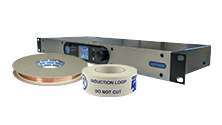Millions of hearing aid users would love to attend and enjoy live music events, but it’s difficult to hear the act in noisy festivals or when standing a long way from the stage. The solution exists, but it isn’t being used, why?
With summer coming to a close and the majority of the larger festivals over with, I can’t help but wonder as to whether people with hearing loss have been able to experience the same auditory experience that I’ve enjoyed.
Disabled access to festivals has been a hot topic this summer and Attitude is Everything are to be congratulated for their campaign that’s made a lot of headway by encouraging the provision of raised platforms for wheelchair access and BSL interpretation, but there is still a lot of more to offer a wider audience and venue hosts have consistently failed to provide adequate equality of access for people with hearing loss – specifically those who take advantage of telecoil enabled hearing aids or neckloops.
To put this into context there are approximately “1.2 million wheelchair users and 100,000 people using BSL in the UK, whereas more than 10 million (about 1 in 6) people in the UK have some degree of hearing impairment or deafness, and around 2.5 million (about 1 in 4) of them use a hearing aids. This isn’t common knowledge as hearing loss isn’t visually identifiable and is why hearing loss is referred to as the ‘invisible’ disability and why it is frequently overlooked.
Hearing aids are a great assistive technology for people with hearing loss, and cochlear implants are available for those with more profound deafness, but both of these technologies are designed for close quarter’s communication, typically 1 to 1. They struggle to separate the desired signal from the background noise in busy environments and stand no chance of separating the sound of an act on a distant stage from the din of a crowd, even if the user is close to a speaker, so what is the solution?
Assistive Listening Devices are the only solution to such a challenge, as they operate by effectively connecting the user directly to the same signal being amplified by the sound reinforcement system. There are three main types of assistive listening device technology, and in the case of festivals and large outdoor events only Hearing Loops (or induction loops) are viable?
I won’t go into too much detail here about the comparison between Assistive Listening Devices but I will briefly outline why some are inappropriate for festival usage; Infra-Red systems for example have problems with being used in direct daylight, and with both Infra-Red and FM systems it is necessary to hand out receivers and/or neckloops to each person who wishes to connect to the audio signal. I probably don’t need to explain what a logistical nightmare that would be at the likes of Glastonbury with an attendance of over 100,000, or what the chances are of people returning the expensive equipment. Also both IR and FM require a line of sight with signal transmitters and receivers so in the case of a large crowd you may find that people moving in and out of the way cause you to have an inconsistent signal. In addition to this people are more likely to actually use a hearing loop as it’s a dignified solution, as each individual is carrying their own receiver and is not required to identify themselves by asking for or wearing any extra technology.
Traditionally event organisers have either been unaware of hearing loops or when informed have used the excuse that they aren’t an appropriate solution as they were difficult to install in outdoor areas such as fields, that they couldn’t cover the necessary area or that they caused interference with electrical instruments and equipment.
This however is simply not true. We know this as we designed the largest outdoor hearing loop system installed to date at the beautification of Cardinal John Henry Newman (The Pope) on his visit to Cofton Park, Birmingham, where over 52,000 people came to watch, all in the same area at the same time.
Hearing Loops are a great solution for providing equality of access to people with hearing loss at large outdoor events, they are economically viable, quickly installed and easy to remove afterwards. Equality of Access is mandatory in just about every other type of event were sound reinforcement is required – why should music festivals be any different? Hopefully next year hearing aid users will enjoy the same experience as me through an appropriate hearing loop solution.
James Flello


